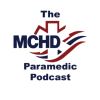The MCHD Paramedic Podcast was launched in early 2018 in an effort to provide easily consumable core-content EMS education and insights from prehospital care thought leaders. The Clinical Services Department of The Montgomery County Hospital District EMS service developed the podcast as a tool to better engage and disseminate continuing education to our MCHD medics as well as first responders and EMS professionals nationwide.
Dr. Casey Patrick is the assistant medical director for Montgomery County Hospital District EMS and is a practicing emergency physician in multiple community emergency departments across Greater Houston. His EMS educational focus is on innovative paramedic teaching via the MCHD Paramedic Podcast. Dr. Patrick’s prehospital clinical research involves the investigation of paramedic use of bolus dose intravenous nitroglycerin for acute pulmonary edema and the implementation of lung protective ventilation strategies for intubated EMS patients. Casey and his wife, Alyssa, work and live in Conroe, Texas, and Spokane, Washington. Together they have five children: Mia, Ainsley, Brock, Dean and Will.
Dr. Dickson graduated with honors from the University of Texas Health Science Center San Antonio in 2001 and completed emergency medicine training at Indiana University in 2004. He serves as the EMS medical director at Montgomery County Hospital District EMS and an assistant professor of emergency medicine at Baylor College of Medicine in Houston, Texas. His academic interests include systems of care in stroke and other time-sensitive emergencies, neurologic emergencies and education. He is board certified in emergency medicine in both the U.S. and Australasia, and has subspecialty board certification in EMS medicine. He has authored multiple professional articles and presented at regional, national and international conferences on emergency medicine and EMS topics.













